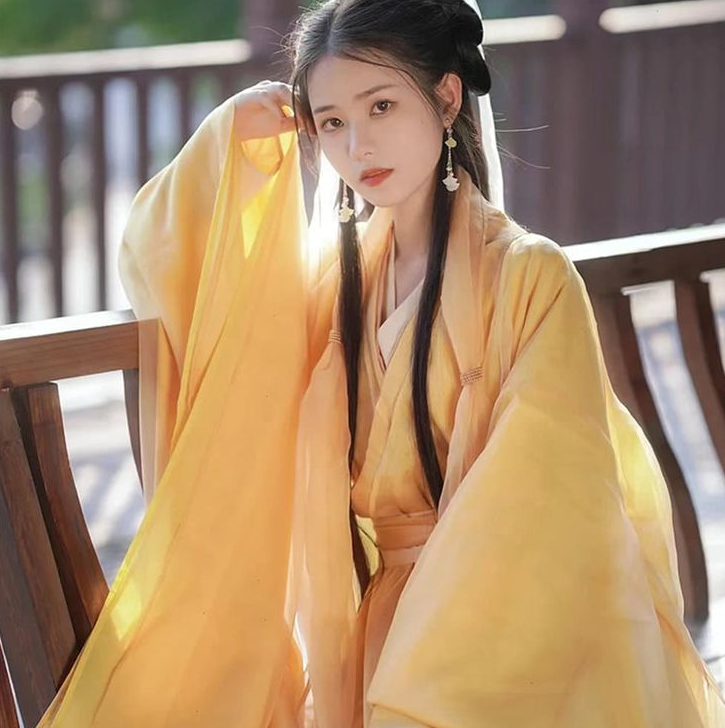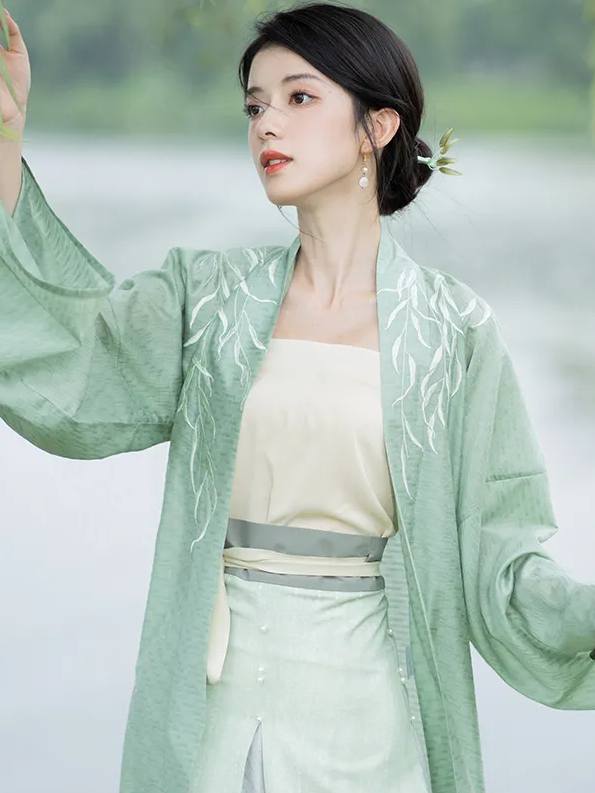The Hanfu dress period began in ancient China and spanned from the Xia Dynasty to the Ming Dynasty.
The Historical Timeline of Hanfu
Pre-Qin Dynasty Hanfu Styles
- Early Origins and Development: Hanfu can be traced back to the primitive societies of ancient China. By the time of the Xia, Shang, and Zhou dynasties, sophisticated systems of attire and ornaments had developed. Patterns were simplistic, with garments being wide and loose.
- Materials and Techniques: The primary materials included hemp, with silk slowly becoming popular towards the end of this period. Dyeing and embroidery techniques were rudimentary but set the stage for future advancements.

Han Dynasty: The Golden Age of Hanfu
- Innovations in Style: This era saw a significant transformation in Hanfu styles with the introduction of the shenyi, a one-piece robe. This period is often regarded as the pinnacle of Hanfu development.
- Popularization of Silk: Silk became the dominant material, leading to more intricate designs and a luxurious feel to the garments.
The Three Kingdoms, Jin, and Southern and Northern Dynasties
- Diverse Styles for Diverse Kingdoms: Different kingdoms had slightly varied styles reflecting their cultures and preferences.
- Influence of Wars: With frequent wars and migrations, the Hanfu saw some alterations, with practicality becoming a key factor in design.
Tang, Song, and Yuan Dynasties: Evolutions and Adaptations
- Tang Dynasty’s Flourishing Fashion: Hanfu in the Tang dynasty was vibrant, reflecting the dynasty’s cosmopolitan nature. Women’s fashion, in particular, was diverse, ranging from high-waisted dresses to wide-sleeved blouses.
- Song and Yuan Modifications: While the Song dynasty favored simpler designs, the Yuan dynasty, under Mongol rule, integrated some elements from Central Asia into the Hanfu.
Ming Dynasty: The Last Bloom of Hanfu
- Conservative yet Refined Styles: The Ming Dynasty favored a return to more traditional styles but with a high degree of refinement. Garments became more form-fitting, with detailed embroidery and patterns.
- End of an Era: Towards the end of the Ming dynasty, Hanfu began to decline, slowly replaced by Manchu clothing, setting the stage for the Qing Dynasty’s distinct fashion.
Characteristics and Components of Hanfu
Basic Structure and Elements
- Cross-Collar and Right Lapel: Traditional Hanfu is recognized by its cross-collar with the right lapel covering the left. This design is believed to embody the Chinese philosophy of yin and yang.
- Wide Sleeves: Hanfu is well-known for its broad sleeves, which offer both aesthetic beauty and practicality. The wide sleeves allow for ease of movement and are symbolic of elegance.
- Sash Belt: A wide sash belt is typically worn around the waist, serving both decorative and practical purposes. It helps adjust the Hanfu to the wearer’s body shape and holds other accessories.
Variations Based on Gender and Status
- Men’s Hanfu: Traditionally, men’s Hanfu might have been more straightforward, with subdued colors like black, white, or navy blue. Notable styles include the “Yi” (tunic worn over a skirt) and the “Shenyi” (a one-piece robe).
- Women’s Hanfu: Women’s versions often display brighter colors and intricate embroidery. Iconic designs are the “Ruqun” (blouse and skirt) and the “Aoqun” (jacket and skirt).
- Status Symbolism: The design, color, and embroidery on the Hanfu could indicate the wearer’s social status. For instance, dragon motifs were predominantly reserved for the emperor, while officials had cranes or other specific emblems.
Materials and Fabric Choices
- Silk: Predominantly used for Hanfu, silk is luxurious, reflecting the wearer’s status and the occasion. It’s prized for its softness, shimmer, and delicate feel.
- Hemp and Linen: More common among ordinary citizens, these materials were economical and offered durability, especially during summer months.
- Brocade and Satin: For special occasions or the elite class, brocades with intricate woven designs and satins with a glossy finish were preferred. These fabrics were often adorned with gold or silver threads, increasing their value significantly.
Hanfu in Rituals and Ceremonies
Traditional Celebrations and Hanfu
- Lunar New Year: As the most important festival in Chinese culture, Hanfu plays a central role. During this period, many choose to wear Hanfu to reconnect with their cultural roots. Brightly colored Hanfu, especially in red, becomes a popular choice to symbolize prosperity and good fortune for the upcoming year.
- Dragon Boat Festival: This event sees a mix of casual and traditional Hanfu, as many participate in boat races or engage in festive activities. Hanfu garments designed with dragon motifs or vibrant patterns can often be seen.
- Mid-Autumn Festival: Celebrated under the moonlight, women often wear a specific type of Hanfu called “Yuehua” (moonflower) which is known for its delicate embroidery resembling the moon and stars.
Confucian Ceremonies and Hanfu’s Role
- Confucian Coming of Age Ceremony: Known as the “Gu Li” or “Capping Ceremony”, young men and women wear specific Hanfu to mark their transition into adulthood. The choice of Hanfu reflects their familial roles and responsibilities.
- Confucian Wedding Ceremonies: Traditional Confucian weddings involve both bride and groom wearing Hanfu. The bride often wears a red Hanfu with golden embroidery, representing luck and happiness, while the groom dons a darker shade, symbolizing strength and stability.
- Ancestral Worship: One of the core tenets of Confucianism is the respect for ancestors. During these ceremonies, families wear Hanfu to show respect and honor towards their forefathers. The choice of Hanfu is typically conservative, often in white or muted colors, symbolizing reverence and solemnity.
The Decline and Resurgence of Hanfu
Factors Leading to the Decline of Hanfu
- Manchu Invasion and Qing Dynasty Rule: The Manchu invasion and the subsequent establishment of the Qing Dynasty played a pivotal role in the decline of Hanfu. The Manchus enforced their dress code, especially the “queue” hairstyle and Manchu-style robes, leading to the diminishing prevalence of Hanfu.
- Western Influence and Modernization: With the influx of Western powers and influence, Western-style clothing became synonymous with modernity and progress. This change, especially during the late Qing Dynasty and the early Republic period, further reduced Hanfu’s popularity.
- Economic Constraints: Traditional Hanfu, especially those made from silk, was costly to produce. With economic challenges and changing priorities, fewer people could afford or justify owning these garments.
- Practicality and Changing Lifestyles: As lifestyles evolved, people favored more practical and versatile clothing options. The elaborate designs and requirements of Hanfu didn’t fit well with the fast-paced urban environments of the 20th century.

Modern Hanfu Movement and Revival
- Rising Cultural Pride: The 21st century witnessed a growing sense of cultural pride and identity among young Chinese. They sought connections to their past, leading to the Hanfu movement, which became a symbol of China’s rich history and heritage.
- Social Media and Pop Culture Influence: Platforms like Weibo and Douyin saw influencers and celebrities embracing Hanfu, showcasing its beauty and elegance. Additionally, TV shows set in historical periods reignited interest in these traditional garments.
- Affordable Options and Production Innovations: Technological advancements and efficient production methods have reduced the costs associated with Hanfu manufacturing. Now, more affordable options are available, making Hanfu accessible to a broader audience.
- Hanfu Events and Gatherings: Various events, including Hanfu parades, exhibitions, and cultural festivals, have sprung up across China, further popularizing the clothing. These events offer enthusiasts a platform to showcase, exchange, and celebrate their passion for Hanfu.
Hanfu’s Influence on Modern Chinese Fashion
The Integration of Hanfu Elements in Contemporary Designs
- Mixing Traditional with Modern: Today’s fashion designers frequently merge traditional Hanfu elements, such as wide sleeves or cross-collars, with modern styles, resulting in unique hybrids that appeal to both traditionalists and modern fashion enthusiasts.
- Use of Traditional Fabrics: Modern Chinese fashion has seen a resurgence in the use of traditional fabrics like silk and brocade. These materials bring a touch of luxury and nostalgia to contemporary designs.
- Incorporation of Patterns and Motifs: Iconic patterns, such as dragon and phoenix motifs or intricate floral designs from Hanfu, are now commonly seen in modern dresses, blouses, and even accessories like handbags and shoes.
- Footwear Evolution: Taking cues from Hanfu-era footwear, many modern shoe designs feature elevated platforms, embroidered patterns, or materials like silk, reminiscent of historical styles.
Hanfu-inspired Fashion Shows and Events
- Runway Highlights: Major fashion weeks in cities like Shanghai and Beijing often feature segments dedicated solely to Hanfu-inspired collections, showcasing the versatility and timeless beauty of these designs.
- Themed Events and Galas: High-profile events, such as movie premieres or art gallery openings, sometimes adopt a Hanfu theme, where attendees don modern takes on traditional outfits, highlighting the blend of old and new.
- Fashion Institutes and Hanfu: Leading fashion schools in China now offer courses and workshops focused on Hanfu design, history, and its influence on modern fashion. This academic approach ensures that future designers have a deep understanding of Hanfu’s significance.
- Collaborations with International Brands: Recognizing the global appeal of Hanfu elements, international brands have collaborated with Chinese designers to launch special edition lines that infuse Hanfu-inspired designs, patterns, and materials.
What are the key features of a Hanfu dress?
Key features include a cross-collar, right over left lapel, wide sleeves, and a sash belt around the waist.
When did silk become a dominant material for Hanfu?
Silk became dominant during the Han Dynasty, symbolizing luxury and status.
How did the Manchu invasion impact Hanfu popularity?
The Manchu invasion and the subsequent Qing Dynasty led to the enforcement of Manchu dress codes, causing a decline in Hanfu's popularity.
What’s the significance of colors in Hanfu designs?
Colors, like red, signify prosperity and good fortune, while darker shades like black or navy blue denote strength and stability.
Why did Hanfu experience a decline in the 20th century?
Factors include Western influence, modernization, economic constraints, and the preference for more practical clothing in urban environments.
How have social media platforms influenced the Hanfu movement?
Platforms like Weibo and Douyin have showcased influencers and celebrities wearing Hanfu, leading to its resurgence among the younger generation.
Which modern events showcase Hanfu-inspired designs?
Modern events like Shanghai and Beijing fashion weeks often feature segments dedicated to Hanfu-inspired collections.
Are there any courses on Hanfu in modern fashion institutes?
Yes, leading fashion schools in China now offer courses focused on Hanfu design and its influence on contemporary fashion.